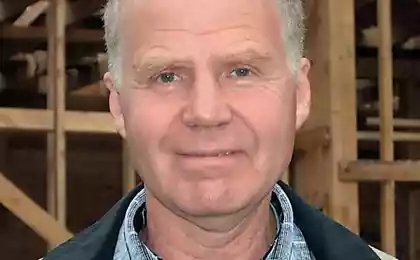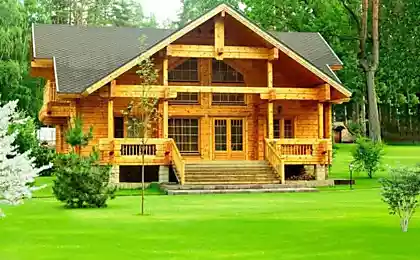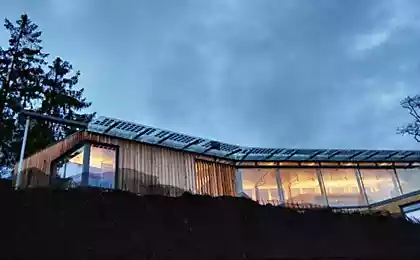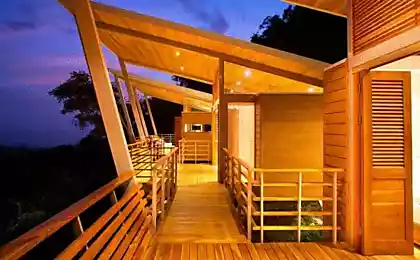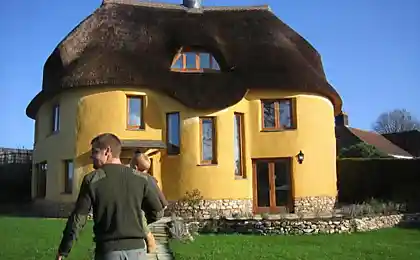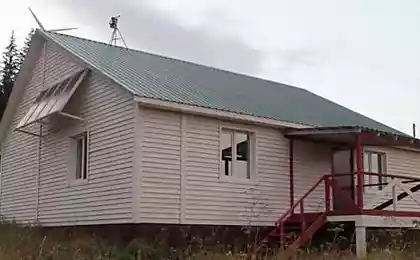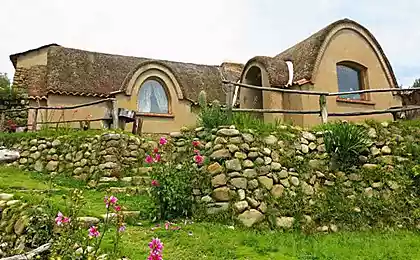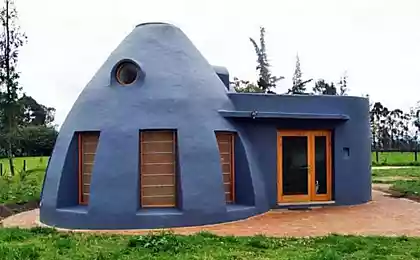516
Energy saving at home: a global perspective
Passive house, eco home, energy-efficient home... energy-Saving technologies is not only insulated walls, solar collector and heat pump. What are the qualities of a low-energy house and passive house to be in harmony with nature?
Today are increasingly found the projects of energy-saving houses. The world is looking for cheap and clean energy. Stocks of coal and oil running out, energy sources are getting more expensive, undermining the world economy. Increases not only economic but also ecological crisis on the Earth begins global warming, there are increasing weather anomalies and natural disasters, and climate change threatens agriculture. And the house, unfortunately, is an active participant in this process. Up to 40% of produced in Europe energy use homes. Need to significantly reduce its consumption, otherwise it may happen that people won't be able to warm and illuminate your home. The house should be less pollute the environment.
Today's high hopes for energy-efficient houses and energy from renewable sources, which can be obtained from wind, solar, and combustion of wood and biofuels. And the houses have significant potential to reduce heat consumption for heating. The house can and should be more environmentally friendly and energy saving. In energy-saving house needs only to use all the available opportunities.
What do we expect from houses? So they are not dependent on fossil energy resources and does not adversely impact on the environment

For the environment and the owner's energy Costs in the life cycle of the building from construction to demolition as follows: 1% construction, 14% – on materials, 85% – on the cost of energy spent on heating and operation of the house. How can I reduce the last digit? It is sufficient to insulate the house and use efficient heating equipment, i.e. to save on heating, without reducing the quality of life.
The possibilities are many. Anyone who wants to use an affordable solution that will build a house that will not only be in harmony with nature, but also save a lot of energy. How much? 40% compared to a conventional house. Some solutions are very simple, they can be used immediately; others require significant costs, special technical and engineering knowledge, professional designer, as well as a thorough work of the installation teams.
Here are examples of simple solutions. In idle state (stand by) home appliances use per day up to 100 watts of energy. It is possible to save by turning them off from the outlet. The refrigerator consumes 20% of the electricity in the house – savings will result from the replacement of the old appliance with a new, energy-saving, category A+++.
Want to save even more? Then it is necessary to reduce the demand for heat. If a passive house heated enough only 15 kWh/(m2•year), then do I have to spend 40 kWh/(m2•year) (so much energy today consumes an average of Europe)? Or 120-150 kWh/(m2•year) (this reflects the cost of energy for newly constructed homes), and the more than 300 kWh/(m2•year) – that is the energy consumed today old houses.
What are the benefits the customer derives from investments aimed at environmental improvement? First of all, lower heating bills and a sense of harmonious living in harmony with nature. But for the environment will have to pay – the construction of energy-efficient houses are more expensive than.
But every year the price decreases. What is the risk that it will not pay off? Small. But investments in energy saving technologies, will pay off soon, however, it needs to be done and for nature conservation, and for the normal life of future generations.
Energy prices are rising means that time is constantly decreasing! If you replace old boiler with a modern condensing and additionally install the heat exchanger, for heating will need to pay 30% less. Optionally, you can equip the house efficient appliances, energy saving lighting and rationally operate the equipment, it is possible without difficulty to reduce the costs of maintaining a home up to 40% compared to a standard home.
Directory of environmental opportunities Environmental and energy saving house – a whole range of opportunities to improve the environment and to save money. You can start with the traditional methods. In this issue, we "will not open America" because about the advantages of building with wood was well known by our ancestors. The novelty is that today it is necessary to look at the house as a whole, not its individual elements. The house itself (materials, construction, equipment), and the style of life of households should be configured for energy savings and environmental conservation.
Low-energy house: the isolation of home. This is the solution that most quickly comes to mind. It is necessary to provide insulation of the walls and supporting structures so they do not miss the heat in a passive house. Through the exterior walls take up to 20% of heat through the roof and 35% through the floor – up to 35%. The increase of the layer of insulation gives you an immediate result – the reduction of heat loss.
Isolation is good for the environment and profitable to the owner. The head of the Polish Centre of technical information of the company Isover Henry Kwapis leads to the calculation of insulation glass wool.
Question: how much carbon dioxide is formed during the production of 1 ton of insulation material?
The result of the study: 2195 lbs. And the ton of insulation, used for insulating the house, save for life-cycle home 76 000 kg of CO2. The cost of insulation pays off! Experts say that Ukraine is a cheaper solution would be a massive insulation of houses than building power plants.
An energy efficient house: heat recovery. The presence in an airtight house ventilation with heat recovery is the recognition of necessity. Significant savings can be obtained not through the use of insulation, and thanks to the recovery, noted at the conference, organized by the firm Rehau, Walter brown an architect from Germany, designing a passive house. The real energy return is 25% of the total heat loss. Other parameter: recuperator returns 25 kWh/(m2•year), and he consumes just 3.8 kWh/(m2•year).
House with natural ventilation irrevocably lose to 40% of the delivered energy. Care should be taken to the inside of the house was decorated in ecological materials, and the quality of the air was high – nearly 90% of our lives we spend in the four walls. If the house is too tight, the person has to breathe the air that contains excessive amounts of CO2, which is bad for his health.
The project of energy saving at home. He must respond to the needs and expectations of the customer. In General it should be small, compact and therefore cheaper in maintenance. The roof is better to do a gable that she had a complicated configuration. The house should be large, South-facing window (the maximum use of solar heat and natural light) is a significant area of Windows on each side.
Materials energy-efficient home. It is best to choose a material from renewable raw materials, such as wood. Preference is given to materials whose production is not associated with large emissions of CO2 and SO2, that is maloprimetny. From the environmental point of view, important are the acquisition of materials near of construction (reducing losses associated with transport), the possibility of processing and availability of information about the product. published
P. S. And remember, only by changing their consumption — together we change the world! ©
Join us in Facebook and in Vkontakte, and we're Classmates
Source: www.muratordom.com.ua/glavnaya-stranitsa/bolee-teplyj-dom-eto-okupaetsya/mir-ishchet-energiyu-energosberegayushchii-dom-ee-nakhodit,295_26164.html
Today are increasingly found the projects of energy-saving houses. The world is looking for cheap and clean energy. Stocks of coal and oil running out, energy sources are getting more expensive, undermining the world economy. Increases not only economic but also ecological crisis on the Earth begins global warming, there are increasing weather anomalies and natural disasters, and climate change threatens agriculture. And the house, unfortunately, is an active participant in this process. Up to 40% of produced in Europe energy use homes. Need to significantly reduce its consumption, otherwise it may happen that people won't be able to warm and illuminate your home. The house should be less pollute the environment.
Today's high hopes for energy-efficient houses and energy from renewable sources, which can be obtained from wind, solar, and combustion of wood and biofuels. And the houses have significant potential to reduce heat consumption for heating. The house can and should be more environmentally friendly and energy saving. In energy-saving house needs only to use all the available opportunities.
What do we expect from houses? So they are not dependent on fossil energy resources and does not adversely impact on the environment

For the environment and the owner's energy Costs in the life cycle of the building from construction to demolition as follows: 1% construction, 14% – on materials, 85% – on the cost of energy spent on heating and operation of the house. How can I reduce the last digit? It is sufficient to insulate the house and use efficient heating equipment, i.e. to save on heating, without reducing the quality of life.
The possibilities are many. Anyone who wants to use an affordable solution that will build a house that will not only be in harmony with nature, but also save a lot of energy. How much? 40% compared to a conventional house. Some solutions are very simple, they can be used immediately; others require significant costs, special technical and engineering knowledge, professional designer, as well as a thorough work of the installation teams.
Here are examples of simple solutions. In idle state (stand by) home appliances use per day up to 100 watts of energy. It is possible to save by turning them off from the outlet. The refrigerator consumes 20% of the electricity in the house – savings will result from the replacement of the old appliance with a new, energy-saving, category A+++.
Want to save even more? Then it is necessary to reduce the demand for heat. If a passive house heated enough only 15 kWh/(m2•year), then do I have to spend 40 kWh/(m2•year) (so much energy today consumes an average of Europe)? Or 120-150 kWh/(m2•year) (this reflects the cost of energy for newly constructed homes), and the more than 300 kWh/(m2•year) – that is the energy consumed today old houses.
What are the benefits the customer derives from investments aimed at environmental improvement? First of all, lower heating bills and a sense of harmonious living in harmony with nature. But for the environment will have to pay – the construction of energy-efficient houses are more expensive than.
But every year the price decreases. What is the risk that it will not pay off? Small. But investments in energy saving technologies, will pay off soon, however, it needs to be done and for nature conservation, and for the normal life of future generations.
Energy prices are rising means that time is constantly decreasing! If you replace old boiler with a modern condensing and additionally install the heat exchanger, for heating will need to pay 30% less. Optionally, you can equip the house efficient appliances, energy saving lighting and rationally operate the equipment, it is possible without difficulty to reduce the costs of maintaining a home up to 40% compared to a standard home.
Directory of environmental opportunities Environmental and energy saving house – a whole range of opportunities to improve the environment and to save money. You can start with the traditional methods. In this issue, we "will not open America" because about the advantages of building with wood was well known by our ancestors. The novelty is that today it is necessary to look at the house as a whole, not its individual elements. The house itself (materials, construction, equipment), and the style of life of households should be configured for energy savings and environmental conservation.
Low-energy house: the isolation of home. This is the solution that most quickly comes to mind. It is necessary to provide insulation of the walls and supporting structures so they do not miss the heat in a passive house. Through the exterior walls take up to 20% of heat through the roof and 35% through the floor – up to 35%. The increase of the layer of insulation gives you an immediate result – the reduction of heat loss.
Isolation is good for the environment and profitable to the owner. The head of the Polish Centre of technical information of the company Isover Henry Kwapis leads to the calculation of insulation glass wool.
Question: how much carbon dioxide is formed during the production of 1 ton of insulation material?
The result of the study: 2195 lbs. And the ton of insulation, used for insulating the house, save for life-cycle home 76 000 kg of CO2. The cost of insulation pays off! Experts say that Ukraine is a cheaper solution would be a massive insulation of houses than building power plants.
An energy efficient house: heat recovery. The presence in an airtight house ventilation with heat recovery is the recognition of necessity. Significant savings can be obtained not through the use of insulation, and thanks to the recovery, noted at the conference, organized by the firm Rehau, Walter brown an architect from Germany, designing a passive house. The real energy return is 25% of the total heat loss. Other parameter: recuperator returns 25 kWh/(m2•year), and he consumes just 3.8 kWh/(m2•year).
House with natural ventilation irrevocably lose to 40% of the delivered energy. Care should be taken to the inside of the house was decorated in ecological materials, and the quality of the air was high – nearly 90% of our lives we spend in the four walls. If the house is too tight, the person has to breathe the air that contains excessive amounts of CO2, which is bad for his health.
The project of energy saving at home. He must respond to the needs and expectations of the customer. In General it should be small, compact and therefore cheaper in maintenance. The roof is better to do a gable that she had a complicated configuration. The house should be large, South-facing window (the maximum use of solar heat and natural light) is a significant area of Windows on each side.
Materials energy-efficient home. It is best to choose a material from renewable raw materials, such as wood. Preference is given to materials whose production is not associated with large emissions of CO2 and SO2, that is maloprimetny. From the environmental point of view, important are the acquisition of materials near of construction (reducing losses associated with transport), the possibility of processing and availability of information about the product. published
P. S. And remember, only by changing their consumption — together we change the world! ©
Join us in Facebook and in Vkontakte, and we're Classmates
Source: www.muratordom.com.ua/glavnaya-stranitsa/bolee-teplyj-dom-eto-okupaetsya/mir-ishchet-energiyu-energosberegayushchii-dom-ee-nakhodit,295_26164.html
